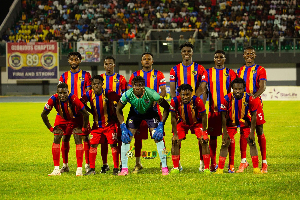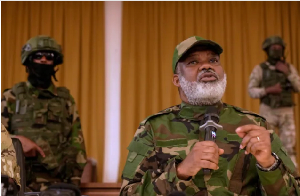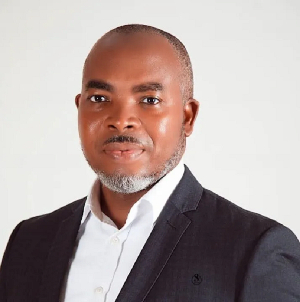*As Prof. Akosa's Name Pops Up And How 25 Victims Were Mass Buried*
In the heat of investigations into the Serial Killings of the 34 women, the Ghana Police Service, headed by Mr. Peter Nanfuri, committed a very serious mistake which otherwise would have revealed whether or not the women were, indeed, killed here in Ghana or were corpses brought from outside the country and dumped in the city to cause fear.
The police administration, at the time of the serial killings, had engaged the services of a fake medical doctor by name Dr. Sowa Boite Maale-Adjzei (picture), as a pathologist who worked on 30 of the victims at the Police Hospital Mortuary in Accra.
Dr. Maale-Adjei’s postmortem reports on the corpses simply declared that the victims died of “strangulation, broken necks and rape.”
The condoms which were found at the scene allegedly with fresh sperms in them were not subjected to further test by the police to know whether they tallied with Charles Quansah’s sperms as the strongest prove of his guilt.
The assessment of Quansah’s mental faculty by a competent psychiatrist as to whether he was sane or not was not an issue during the trial. Hence his motive for allegedly killing the women was not established although the police faintly suggested that he was mad.
When the Police Service discovered Dr. Maale-Adjei’s status after a long probe led by Prof. Agyeman Badu-Akosa, himself a pathologist, he was not arrested and prosecuted, but was secretly dismissed from the mortuary to go scot-free. He later got engaged at the Ridge Hospital in Accra, again as a pathologist.
This came to light when this reporter, then working for the Network Herald newspaper, visited the mortuary some years ago to ascertain how the victims of the serial killings were claimed. It emerged that 25 of the dead bodies were not collected by their relatives.
The Police administration tasked the Dental and Medical Council to look into the postmortem reports on the victims of the Serial Killings and certain unethical acts committed by Dr. Maale-Adjzei, who hails from Kowe, a suburb of Labadi, in Accra.
Dr. Maale-Adjzei passed every dead body, especially females, brought to the Police Hospital Morgue as a victim of the serial Killings.
He also extorted huge sums of monies from people who brought their dead relatives there for preservation before performing autopsy on them.
He could sneak into the morgue, sometimes at dawn, and fetch a copse for a relative, and pocket the fee instead of asking that the fee be paid to cashier of the hospital.
His luck ran out when he declared another corpse, a female, brought down from Keta in the Volta Region, as a victim of the serial killings.
The police got alarmed at his finding, and called in another pathologist whose postmortem report revealed that the woman rather died of a natural cause and not through strangulation as in the case those found in Accra.
The Dental and Medical Council was then tasked to look into the medical qualification of Dr. Maale-Adjzei, who had claimed to be a Russian-trained medical doctor.
He was asked to produce his certificate, but he failed to that thus confirming the doubts over his qualification.
He was subsequently dismissed from the Police Hospital and he did not challenge the dismissal.
The Herald is reliably informed that he is currently working with a clinic after the Nungua Barrier off the Tema main road. He resides at East Legon, also in Accra.
Mass Burial
for Victims
The police officer in-charge of the Police Mortuary at the time, DSP Abu, now deceased, informed this reporter that twenty five (25) of the murdered women were mass buried at the Mile 11 Public Cemetery, off the Accra-Winneba Road, to decongest the facility and make way for new arrivals.
Five (5) were identified and claimed by their relations for burial here in Ghana.
The decision for the mass burial for the 25 was arrived at after tireless efforts by the Police Hospital authorities to reach persons who had lost sudden contact with close relations who could possibly be victims of the dastardly act to identify and collect their lost ones.
Countless announcements were made in both electronic and print media, with photographs to this effect. However, though ten of the victims were duly identified, only five of them were collected for burial by their family members.
DSP Abu brought out a book in which postmortem reports on the victims said that most of the women died as a result of strangulation, while some ten, or so of them, were raped before being strangled to death.
“They had sperms and severe bruises on the vagina, indicating they were raped prior to their untimely death.”, the reports said.
Confronted with the failure on the part of the general public to identify and claim the corpses, the hospital had no other option but resort to mass burial to reduce the enormous pressure that was being placed on the hospital’s morgue to prevent it from a possible breakdown.
He said that some of the persons who reported at the mortuary to check on the dead said that they were Liberians, Togolese and Nigerians and friends of some of the victims with whom they practiced prostitution in Ghana.
The most plausible conclusion was that the unclaimed bodies were those of victims who were foreigners who lived in the country and practised prostitution.
For instance, a Nigerian lady who described herself as a friend of Theresa Mavis Tino, a 28-year Nigerian who was killed at Teshie in 1999, came to the mor
tuary to collect her friend, but the authorities refused to release the body without the consent of the deceased’s family.
Even when the lady returned to the hospital with a report that the relations of Mavis had refused to come down to collect their corpse because according them she brought Mavis to Ghana to practise prostitution, and therefore must be responsible for what has happened and bury her, the hospital refused to budge to her demand.
She subsequently left and never returned.
DSP Abu who said he was not part of the investigation but claimed adequate information from the investigators, reiterated that the places where the women were dumped were very different from the spots where they were killed.
General News of Wednesday, 1 December 2010
Source: The Herald
















